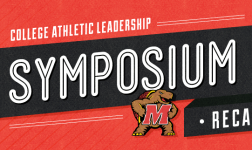By Jeff Roeske — Marquette University, President of the Sports Law Society, Executive Editor of the Marquette Sports Law Review — and Peter Baran, Director of Compliance at Villanova University.
Key Insights
An effective compensation clawback provision can go a long way in protecting the best interests of a university. Between a new NCAA penalty structure and more responsibility being placed on head coaches, a clawback clause provision can ensure programs are protected, while providing coaches with a greater incentive to keep their programs on the straight and narrow.
With the NCAA’s rule changes increasing the accountability of head coaches for the actions of their programs 1, it may also be an opportune time for athletic directors and administrators to consider extra safeguards when signing coaches to a contract. One possibility is something borrowed from the business world 2: When negotiating, ADs may consider a compensation clawback provision within coaching contracts. 3
A clawback provision is defined as a “provision in a law or contract that limits or reverses a payment or distribution for specified reasons.” 4 Recent penalties leveled against several universities provide a window through which to consider the importance of legal mitigation in coach contracts. 5
Coach Compensation Clawback Model Clause
The success of a clawback provision depends on the contract language. A poorly written clause, like any contract, creates numerous problems for parties on both sides of the table. In an effort to prevent that, the following clause is offered as a model for universities to utilize as a starting point in negotiations. Areas in red, which will be discussed in more detail, are terms that will need to be negotiated between the parties. The model clause reads as follows:
First, it is important to include (as the above clause does) the levels of the NCAA violations that will make the clause actionable and where the definition of those levels can be found. Additionally, always include what penalties trigger the clause. If the intent is only to punish or recoup damages from a coach when certain penalties are levied against the institution, then those details need to be included in the clause. Third, it is important to state what type (lump sum, bonuses, etc.) of compensation is owed if the clause goes into effect. The final necessity is to state a period of time that the coach is required to reimburse the school.
Another option to include in the clause is language that provides for a sliding scale of repayment, depending on the level of violation. Thought Leaders & Emerging TrendsIf there were significant clawback provisions in the contracts for athletic directors and coaches as I proposed to our board of regents, I guarantee they would be more vigilant about what happens on their watch. Read moreCoaches may favor this option, as each violation would be treated with a corresponding level of repayment. A university may also require a certain percentage of salary to be held in a separate interest-building account or escrow until a coach leaves the program. If the coach leaves with no penalties levied against the program, the coach would be entitled to all the money in that account; however, a NCAA penalty would trigger a payout from the account to the university. This type of provision protects against a coach being unable to pay if a violation occurs. Including the basic clause as written above will, at the minimum, provide universities with a greater deal of protection and leverage against rule-breaking coaches.
The Effect of NCAA Rule Changes on the Model Clause
On August 1st, 2013, the NCAA’s new rules enforcement penalty structure will take effect, 6 which should—to an even greater extent—encourage institutions to consider a clawback provision in its coaching contracts. 7
The penalty structure divides rules violations into four levels. This is to be contrasted with the current structure that divides penalties between secondary violations (those that are inadvertent or provide a minor competitive advantage) and major (all other violations).
Under the new penalty structure, level one violations—such as academic fraud—are the most egregious violations. Level two violations 8 are less egregious, but still serious violations of NCAA rules 9. Level three violations are what would currently be considered secondary violations 10. They are those violations that are unintentional and provide only a minor competitive advantage. Level four violations are clerical-type violations that will be processed at the conference-office level. 11
Along with these new rules violations, there is a renewed consideration of mitigating and aggravating factors 12. For any violations, the NCAA can examine the actions of the institution, including coaching and administrative staff, to either raise or lower the level of the violation. For example, an institution may have exceeded its permissible limit of recruiting contacts. Typically, this would be a level three violation; however, if a coaching staff member lies to the NCAA or otherwise obstructs the process, for example, the NCAA can decide to raise the level of the violation to level two.
The new structure carries with it increased penalties as well. Although there is no rubric for determining the penalties, institutions should assume that the new structure will carry with it an intense focus on penalties, especially for the most egregious and repeat rules violators. 13
Each aspect of the new penalty structure should encourage institutions to seriously consider incorporating clawback provisions into their coaching contracts. A clawback provision has two benefits in this regard. First, it encourages coaches to adhere to the rules because there is a significant financial incentive to do so. That incentive should encourage coaches to not only avoid violations, but to mitigate them when they do occur. Second, the clawback provision takes some of the financial sting out of the penalties an institution may incur as a result of the coach’s actions.
Closing Thoughts
As noted previously, all areas in red of the model clause in this article should be carefully negotiated between parties. Each institution has its own unique criteria and will, ultimately, know best how to tailor the language of the clause to fit its specific needs. Although every contract is a negotiation, and getting a coach to agree to this type of a clause may require concessions in other areas, it is a worthwhile consideration given the pervasiveness and heightened seriousness of NCAA rules violations.
References:
- See John Infante, Head Coach Responsibility a Potential Gamechanger, ATHNET (June 13, 2013), http://www.athleticscholarships.net/2013/06/13/head-coach-responsibility-a-potential-gamechanger.htm. ↩
- Ilona Babenko et al, Clawback Provisions (June 5, 2012), http://www.efa2012.org/papers/f1b3.pdf ↩
- See http://www.nytimes.com/2013/08/04/business/clawbacks-in-word-not-deed.html?ref=business&pagewanted=all ↩
- Clawback Provisions Law & Legal Definition, USLEGAL, http://definitions.uslegal.com/c/clawback-provisions/ (last visited July 14, 2013). ↩
- In Oregon, the NCAA stripped the university of one scholarship in each of the next three seasons and placed the university on probation for the next three years. The coach received an eighteen-month show-cause penalty, but because of a departure to the NFL, the university had to face these penalties without redress against the employee who brought them about. Other examples of similar situations have occurred at USC, UMass and Memphis (although the coach was never charged by the NCAA).
See also:
Associated Press, Oregon Placed on Probation by NCAA, FOX SPORTS, http://msn.foxsports.com/collegefootball/story/oregon-ducks-placed-on-three-year-probation-by-ncaa-no-postseason-ban-recruiting-case-062613 (last updated June 26, 2013)Paul Pringle, Carroll’s Rules Violations Could Hurt USC, LOS ANGELES TIMES (July 14, 2010), http://articles.latimes.com/2010/jul/14/local/la-me-pete-carroll-20100714.
Lynn Zinser, U.S.C. Sports Receive Harsh Penalties, N.Y. TIMES, June 11, 2010, at B9, available at http://www.nytimes.com/2010/06/11/sports/ncaafootball/11usc.html?_r=0, http://nesn.com/2010/07/pete-carroll-usc-under-ncaa-investigation-for-yet-another-violation/.
Gary Parrish, Just Like UMass, Calipari’s Accomplishments at Memphis are Tainted, CBSSPORTS.COM (May 28, 2009), http://www.cbssports.com/collegebasketball/story/11793826.
S.L. Price, Too Slick, Too Loud, Too Successful Why John Calipari Can’t Catch a Break, SI VAULT (Mar. 14, 2011), http://sportsillustrated.cnn.com/vault/article/magazine/MAG1182972/.
↩ - See NCAA, Announcement, http://www.ncaa.org/wps/wcm/connect/public/ncaa/resources/latest+news/2013/august/new+reform+efforts+take+hold+august+1 ↩
- See Gary Brown, Board Adopts Tougher, More Efficient Enforcement Program, NCAA.ORG (Oct. 10, 2012), http://goo.gl/l50G3. ↩
- The NCAA defines level one violations as “[v]iolations that seriously undermine or threaten the integrity of the NCAA collegiate model as set forth in the Constitution and its bylaws, including any violation that provides or is intended to provide a substantial or extensive recruiting, competitive, or other advantage, or a substantial or extensive impermissible benefit.” Id. ↩
- “Violations that provide or are intended to provide more than a minimal but less than a substantial or extensive recruiting, competitive or other advantage; includes more than a minimal but less than a substantial or extensive impermissible benefit; or involves conduct that may compromise the integrity of the NCAA collegiate model as set forth in the Constitution and bylaws.” Id. ↩
- “Violations that are isolated or limited in nature; provide no more than a minimal recruiting, competitive or other advantage; and do not include more than a minimal impermissible benefit. Multiple Level IV violations may collectively be considered a breach of conduct.” Id. ↩
- “Minor infractions that are inadvertent and isolated, technical in nature and result in a negligible, if any, competitive advantage. Level IV infractions generally will not affect eligibility for intercollegiate athletics. (This level may be revised or even eliminated pending outcomes from the Rules Working Group’s efforts to streamline the Division I Manual.).” Id. ↩
- See e.g., Ben Kercheval, NCAA Formally Adopts New Penalty Structure, (Oct. 30, 2012), http://collegefootballtalk.nbcsports.com/2012/10/30/ncaa-formally-adopts-new-penalty-structure/. ↩
- See e.g., NCAA Approves Tougher Sanctions for Rule-Breakers, (Oct. 30, 2012), http://www.cbssports.com/collegefootball/story/20751225/ncaa-approves-tougher-sanctions-for-rulebreakers. ↩




